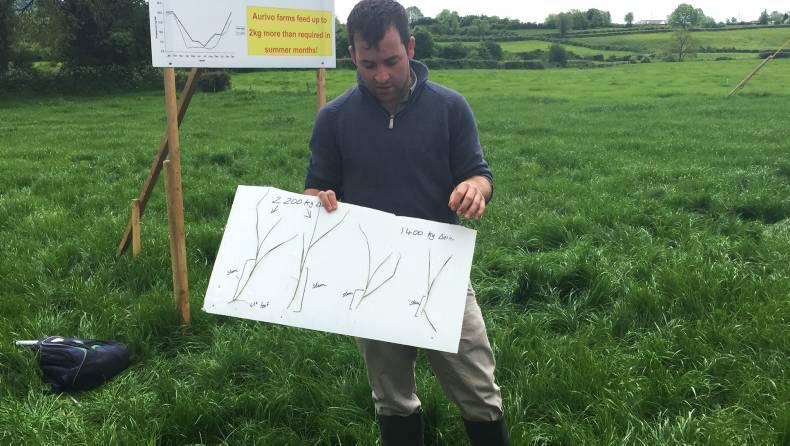The first and most important thing to say about pre-mowing is that it should not be used to manage surplus grass. With surplus grass on most farms, due to massive grass growth rates over the past three weeks, pre-grazing yields have risen and it is harder to get cows to clean out paddocks.
A pre-mowed paddock looks great – no dungpads, no weeds and a clean, consistent cutting height. But is this what the cow wants? The reason why cows graze poorly on a high cover is because there is extra-long stem at the base, which is unpalatable, and the cows, if given a choice, will refuse to eat it.
But in pre-mowed paddocks, the cow’s ability to select grass is reduced in much the same way as it is with zero grazing, so pre-mowing high covers will decrease the quality of the feed going into the cow.
If you have surplus grass paddocks (you will know by checking pre-grazing covers and doing a farm grass walk), then cut a few surplus paddocks but put them into silage rather than feeding to the cows.
The research
What if pre-grazing yield is correct? Will pre-mowing have an effect then? The Irish research on pre-mowing dates back to the 1990s but shows no positive effect on milk yield.
Brendan Horan of Teagasc Moorepark has reviewed research on pre-mowing from New Zealand and had this to say: “The conclusions are that pre-mowing or topping both depress subsequent regrowth by 20% to 25%. Pre-mowing resulted on average in a reduction in milk solids production. While the dry matter content of the diet increased by on average 7% (due to wilting pre-mowing), this was not consistent and the material eaten is of reduced quality (higher fibre content) both at high and low pre-grazing yields.”
Many Irish farmers report a lift in milk yield when good-quality grass is pre-mown. Brendan said this may be so, but there are many factors that govern yield, not just grass dry matter.
“On the whole, our advice to farmers is to graze out paddocks properly, measure cover regularly and skip and bale the poorest-quality grass swards,” he said.
Read more
Phenomenal growth rates as grass soars
The first and most important thing to say about pre-mowing is that it should not be used to manage surplus grass. With surplus grass on most farms, due to massive grass growth rates over the past three weeks, pre-grazing yields have risen and it is harder to get cows to clean out paddocks.
A pre-mowed paddock looks great – no dungpads, no weeds and a clean, consistent cutting height. But is this what the cow wants? The reason why cows graze poorly on a high cover is because there is extra-long stem at the base, which is unpalatable, and the cows, if given a choice, will refuse to eat it.
But in pre-mowed paddocks, the cow’s ability to select grass is reduced in much the same way as it is with zero grazing, so pre-mowing high covers will decrease the quality of the feed going into the cow.
If you have surplus grass paddocks (you will know by checking pre-grazing covers and doing a farm grass walk), then cut a few surplus paddocks but put them into silage rather than feeding to the cows.
The research
What if pre-grazing yield is correct? Will pre-mowing have an effect then? The Irish research on pre-mowing dates back to the 1990s but shows no positive effect on milk yield.
Brendan Horan of Teagasc Moorepark has reviewed research on pre-mowing from New Zealand and had this to say: “The conclusions are that pre-mowing or topping both depress subsequent regrowth by 20% to 25%. Pre-mowing resulted on average in a reduction in milk solids production. While the dry matter content of the diet increased by on average 7% (due to wilting pre-mowing), this was not consistent and the material eaten is of reduced quality (higher fibre content) both at high and low pre-grazing yields.”
Many Irish farmers report a lift in milk yield when good-quality grass is pre-mown. Brendan said this may be so, but there are many factors that govern yield, not just grass dry matter.
“On the whole, our advice to farmers is to graze out paddocks properly, measure cover regularly and skip and bale the poorest-quality grass swards,” he said.
Read more
Phenomenal growth rates as grass soars






 This is a subscriber-only article
This is a subscriber-only article










SHARING OPTIONS: